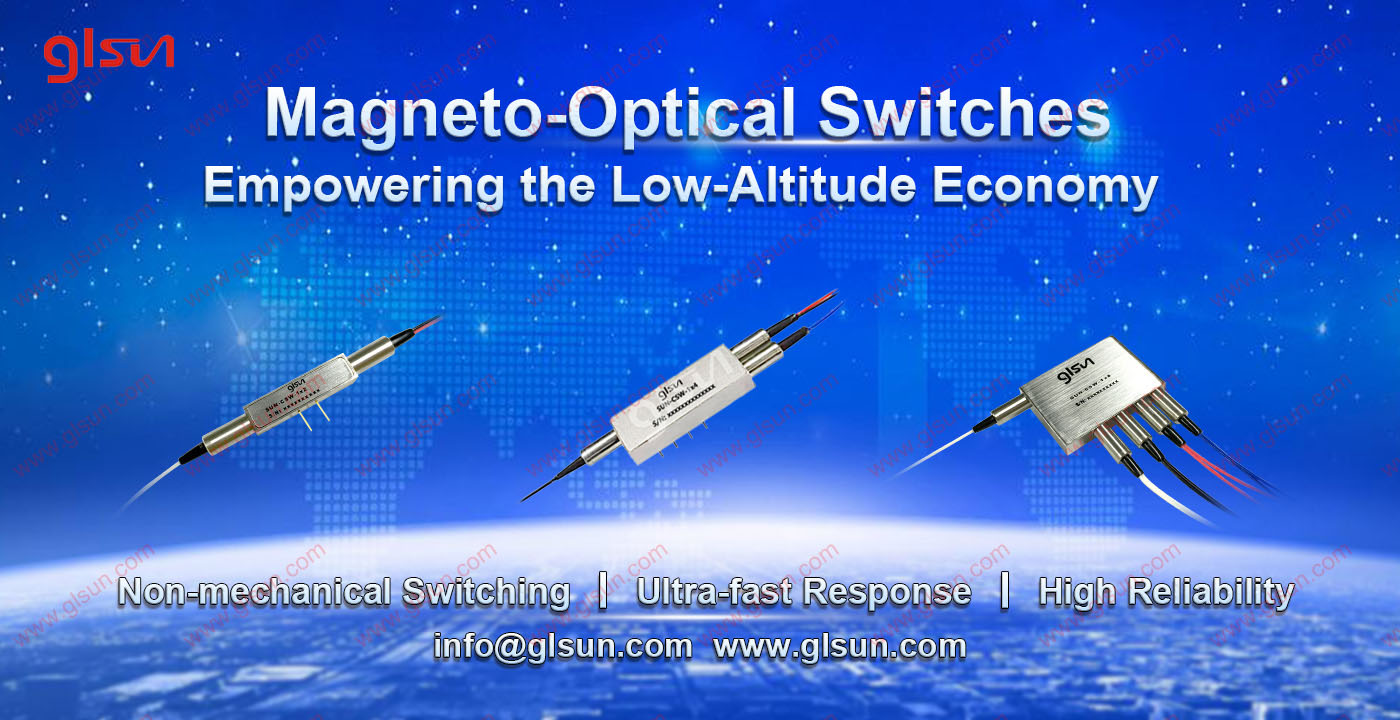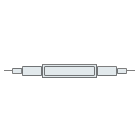Fiber Optic Tech
Magneto-Optical Technology: Revolutionizing Connectivity in the Low-Altitude Economy
The low-altitude economy, encompassing applications such as urban air mobility, drone logistics, and aerial sensing, is rapidly emerging as a transformative force in modern industries. This burgeoning sector relies heavily on advanced communication and sensing technologies to ensure safe, efficient, and reliable operations. Among these technologies, magneto-optical (MO) switches, including standard magneto-optical switches, polarization-maintaining (PM) magneto-optical switches, and high-power polarization-maintaining magneto-optical switches, are proving to be pivotal. Leveraging the Faraday magneto-optical effect, these devices offer unparalleled speed, reliability, and precision in optical signal management, making them indispensable for the low-altitude economy's connectivity and sensing needs. This article explores the principles, advantages, and specific applications of these magneto-optical technologies in the low-altitude economy, highlighting their role in powering the future of aerial innovation.
Understanding Magneto-Optical Technology
Magneto-optical switches operate based on the Faraday effect, a phenomenon where the polarization plane of linearly polarized light rotates when passing through a magneto-optical material under an external magnetic field. This rotation is proportional to the magnetic field strength and the material's length, enabling precise control over optical signal paths. A typical magneto-optical switch comprises components such as a polarization beam splitter (PBS), a Faraday rotator, and a polarization beam combiner (PBC). By modulating the magnetic field, the switch can direct light to different output ports with microsecond-level switching speeds, low insertion loss, and high reliability due to its non-mechanical design.
Compared to traditional mechanical optical switches, magneto-optical switches offer significant advantages, including faster response times (often in the nanosecond range), no moving parts for enhanced durability, and low power consumption. These characteristics make them ideal for applications requiring high-speed, stable, and precise optical signal routing. Polarization-maintaining and high-power variants further enhance their utility by addressing specific challenges in optical communication and high-energy systems.
Applications in the Low-Altitude Economy
The low-altitude economy, defined by operations below 1,000 meters, includes drones, air taxis, and other unmanned aerial vehicles (UAVs) used for logistics, surveillance, environmental monitoring, and urban mobility. These applications demand robust communication networks, precise sensing systems, and reliable data transmission, all of which magneto-optical technologies are uniquely equipped to support. Below, we explore the roles of standard magneto-optical switches, polarization-maintaining magneto-optical switches, and high-power polarization-maintaining magneto-optical switches in this dynamic sector.

1. Magneto-Optical Switches in Aerial Communication Networks
In the low-altitude economy, drones and air taxis require seamless, high-speed communication networks to coordinate flight paths, avoid collisions, and transmit real-time data. Magneto-optical switches are critical in optical communication systems, enabling rapid routing of optical signals in fiber-optic networks. Their high-speed switching capabilities (often less than 10 microseconds) and low crosstalk ensure efficient data transmission with minimal signal distortion, which is essential for maintaining reliable connectivity in dense urban environments where multiple UAVs operate simultaneously.
For example, in drone swarm operations, magneto-optical switches facilitate dynamic optical path switching in dense wavelength division multiplexing (DWDM) systems, allowing multiple data streams to be transmitted over a single fiber with high bandwidth efficiency. Their solid-state design ensures reliability in harsh environmental conditions, such as vibrations and temperature fluctuations encountered during low-altitude flights. Additionally, magneto-optical switches are used in configurable add/drop multiplexers, enabling flexible network configurations to adapt to changing traffic patterns in real-time, a critical feature for dynamic air traffic management systems.
2. Polarization-Maintaining Magneto-Optical Switches in Sensing Systems
Polarization-maintaining magneto-optical switches are designed to preserve the polarization state of light during switching, making them ideal for applications where signal integrity is paramount. In the low-altitude economy, these switches are extensively used in advanced sensing systems, such as coherent Doppler wind LiDAR (Light Detection and Ranging), which is critical for atmospheric monitoring and aviation safety.
Wind LiDAR systems measure wind speed and direction by analyzing the Doppler shift of backscattered laser light. Polarization-maintaining magneto-optical switches play a crucial role in modulating the polarization state of the laser beam, enabling the system to filter out noise and enhance the signal-to-noise ratio. This precision is vital for accurate wind measurements, which inform flight planning, turbulence avoidance, and weather forecasting for low-altitude operations. For instance, in urban air mobility, where air taxis navigate complex wind patterns, these switches ensure that LiDAR systems deliver reliable data for safe navigation.
Moreover, polarization-maintaining magneto-optical switches are used in fiber-optic sensors for monitoring physical parameters such as strain, temperature, and magnetic fields on UAVs. Their ability to maintain polarization ensures high sensitivity and accuracy, enabling real-time structural health monitoring of drones and air taxis, which is essential for operational safety and maintenance.
3. High-Power Polarization-Maintaining Magneto-Optical Switches in Laser-Based Applications
High-power polarization-maintaining magneto-optical switches are engineered to handle significant optical power levels, making them suitable for laser-based applications in the low-altitude economy. These switches are critical in high-energy laser systems used for drone-based LiDAR, laser communication, and industrial applications such as aerial surveying and mapping.
In drone-based LiDAR systems, high-power magneto-optical switches control laser beam intensity and polarization, enabling precise scanning of terrain and infrastructure. For example, in agricultural drones, these switches facilitate high-resolution mapping of crops by directing high-power laser beams with minimal loss and distortion. Their durability under high optical power ensures consistent performance, even in demanding outdoor environments.
Laser communication, an emerging technology for the low-altitude economy, also benefits from high-power polarization-maintaining magneto-optical switches. These switches enable free-space optical communication between drones or between drones and ground stations, offering high-bandwidth, secure data transmission. By maintaining polarization and handling high optical power, these switches ensure low bit-error rates and robust connectivity, even in adverse weather conditions.
Additionally, in defense applications, high-power magneto-optical switches are used in target acquisition and tracking systems mounted on UAVs. Their ability to manage high-energy laser beams with precision supports accurate targeting and surveillance, critical for security operations in low-altitude airspace.
Advantages of Magneto-Optical Technology in the Low-Altitude Economy
The adoption of magneto-optical switches in the low-altitude economy is driven by their unique advantages:
High-Speed Switching: With response times in the microsecond to nanosecond range, magneto-optical switches support real-time data transmission and sensing, critical for dynamic low-altitude operations.
Reliability and Durability: The absence of moving parts eliminates mechanical wear, ensuring long-term reliability in harsh aerial environments.
Low Power Consumption: Magneto-optical switches require minimal electrical power, making them suitable for energy-constrained UAVs.
Polarization Maintenance: PM and high-power PM switches preserve signal integrity, enhancing the performance of sensing and communication systems.
Compact Design: Their small footprint allows integration into compact UAV pay""s, optimizing space and weight.
These advantages position magneto-optical switches as a cornerstone technology for the low-altitude economy, enabling scalable, efficient, and safe operations.
Challenges and Future Directions
Despite their potential, magneto-optical switches face challenges that must be addressed for widespread adoption. Material development remains a key hurdle, as magneto-optical materials with higher Faraday rotation and lower optical losses are needed to enhance performance. Additionally, the complexity of magnetic field control and polarization management increases manufacturing costs, which may limit scalability in cost-sensitive applications.
Integration and packaging also pose challenges. Developing compact, cost-effective packaging solutions is essential for deploying magneto-optical switches in large-scale UAV fleets. Ongoing advancements in materials science, nanotechnology, and photonics are expected to address these issues, driving down costs and improving performance.
Looking ahead, the integration of magneto-optical switches with emerging technologies, such as quantum communication and 6G networks, holds promise for the low-altitude economy. For instance, their potential in quantum networks could enable secure, high-speed data transmission for UAVs, supporting applications like autonomous delivery and smart city infrastructure. Furthermore, advancements in high-power laser systems could expand the use of magneto-optical switches in large-scale aerial mapping and environmental monitoring, contributing to sustainable development.
Magneto-optical technology, encompassing standard, polarization-maintaining, and high-power polarization-maintaining switches, is poised to play a transformative role in the low-altitude economy. By enabling high-speed, reliable, and precise optical signal management, these switches support critical applications in aerial communication, sensing, and laser-based systems. Their advantages in speed, durability, and efficiency make them ideal for the dynamic and demanding requirements of drones, air taxis, and other low-altitude platforms. As research and development continue to address challenges in material performance and cost, magneto-optical switches will unlock new possibilities for connectivity and innovation, powering the future of the low-altitude economy.



















